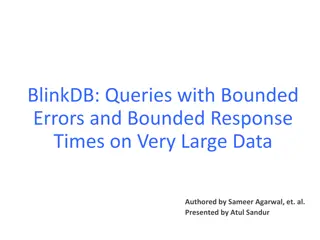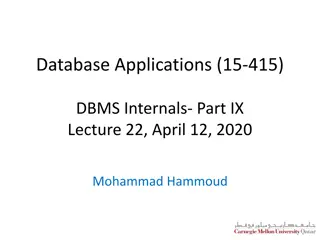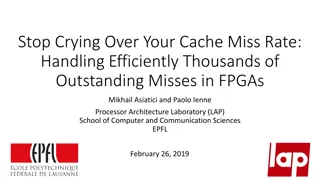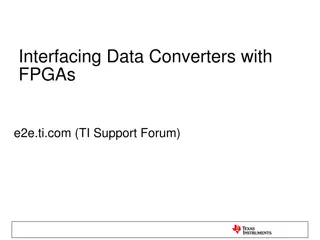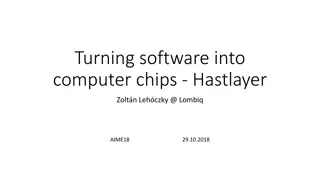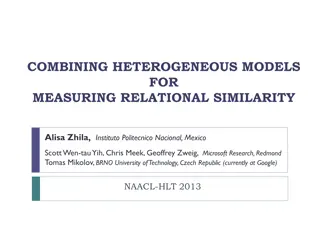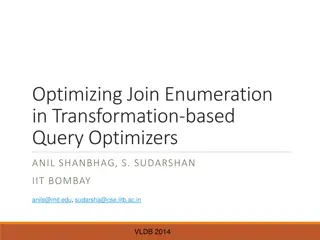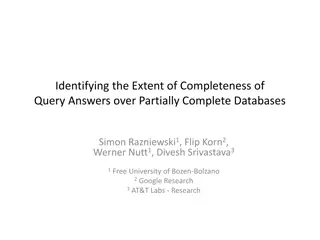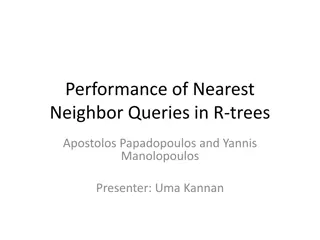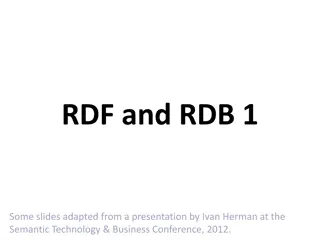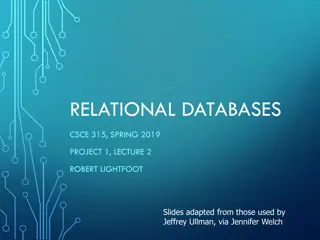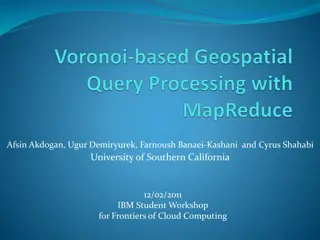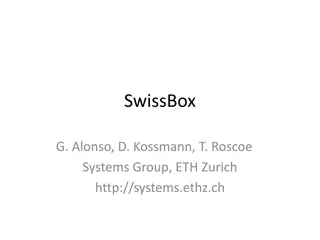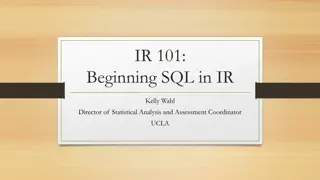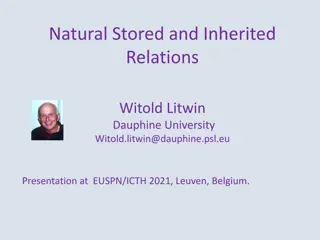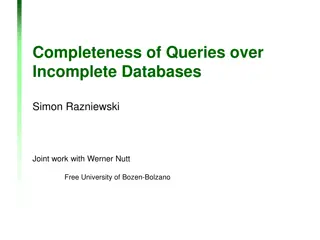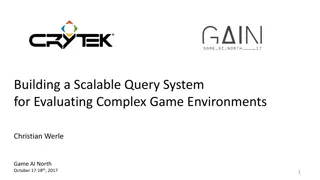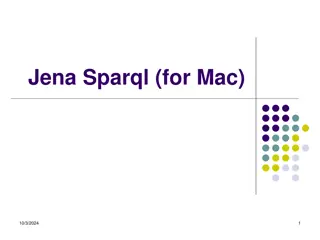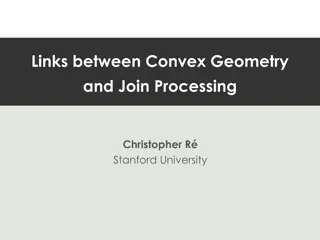Relational Query Processing on OpenCL-based FPGAs
This study explores the efficient processing of relational queries on FPGA hardware using OpenCL, a programming language for heterogeneous computing environments. The evolution of FPGA architectures, optimization methods for OpenCL, and the benefits of kernel vectorization and compute units are discussed in detail.
Download Presentation

Please find below an Image/Link to download the presentation.
The content on the website is provided AS IS for your information and personal use only. It may not be sold, licensed, or shared on other websites without obtaining consent from the author. Download presentation by click this link. If you encounter any issues during the download, it is possible that the publisher has removed the file from their server.
E N D
Presentation Transcript
Relational Query Processing on OpenCL-based FPGAs Zeke Wang, Johns Paul, Hui Yan Cheah (NTU, Singapore), Bingsheng He (NUS, Singapore), Wei Zhang (HKUST, Hong Kong) 1
Outline Background and Problem Challenges Observation Our Solution Experiment Conclusion 2
What is OpenCL? OpenCL stands for Open Computing Language. OpenCL has been developed for heterogeneous computing environments with a host-accelerator execution model. CPU runs the control task. FPGA runs the computing kernel. 3
Architectural Evolution of FPGA Hardware-centric Fine-grained parallelism Users need to program FPGA with hardware description languages (HDL) 4
Architectural Evolution of FPGAs: From OpenCL s Perspective Kernel Logic blocks Private Memory Pipeline ... Memory blocks ... Local Memory Global Memory Interconnect FPGA External DDR Global Memory Users can program FPGA with OpenCL. Software-centric FPGA as a parallel architecture. 5
Optimization Methods for OpenCL Common optimizations Thread Parallelism (TP) Shared Memory (SM) Memory Coalescing (MC) FPGA-specific optimizations Compute Units (CU) Kernel Vectorization (SIMD) 6
Optimization (CU) on FPGA CU-1 CU-2 Private Memory Private Memory Pipeline Pipeline ... ... ... ... ... Local Memory Local Memory Global Memory Interconnect FPGA Global Memory CU: Compute units for the kernel Computing performance doubles. Memory performance: Local memory performance doubles (private to its CU). Global memory performance depends (CUs share). 7
Optimization (SIMD) on FPGA 7 6 5 4 3 2 1 0 A=B+C No SIMD Kernel Vectorization (SIMD):It allows multiple work items (or threads) to execute in single instruction multiple data (SIMD) fashion. 8
Optimization (SIMD) on FPGA 7 6 5 4 3 2 1 0 A=B+C No SIMD Kernel Vectorization (SIMD):It allows multiple work items to execute in single instruction multiple data (SIMD) fashion. 9
Optimization (SIMD) on FPGA 7 6 5 3 2 1 4 0 A=B+C No SIMD With SIMD=4 4 0 A=B+C A=B+C 5 1 A=B+C 6 2 A=B+C 7 3 Kernel Vectorization (SIMD):It allows multiple work items to execute in single instruction multiple data (SIMD) fashion. 10
Optimization (SIMD) on FPGA 7 6 5 3 2 1 4 0 A=B+C No SIMD With SIMD=4 4 0 A=B+C A=B+C 5 1 A=B+C 6 2 A=B+C 7 3 Kernel Vectorization (SIMD):It allows multiple work items to execute in single instruction multiple data (SIMD) fashion. 11
Problem OmniDB [1]: State-of-the-art OpenCL-based query processor on CPU/GPU Kernel-based execution Common optimization methods Cost-based approach to schedule How OmniDB performs on OpenCL-based FPGAs? [1] Shuhao Zhang and et al. OmniDB: Towards Portable and Efficient Query Processing on Parallel CPU/GPU Architectures, VLDB 13. 12
Outline Background and Problem Challenges Observation Our Solution Experiment Conclusion 13
Challenge (Large Exploration Space) A single SQL query can have many possible query execution plans on FPGAs. Each query has multiple operators, and each operator consists of multiple OpenCL kernels. Each OpenCL kernel can have different FPGA- specific optimization combinations. We also consider another dimension of using multiple FPGA images. 14
Challenge (Long Synthesis Time) FPGA Image OpenCL Program 2-4 hours Running all the feasible query plans on real FPGAs is not a good idea. We need one cost model to determine the optimal query plan via evaluation. 15
Outline Background and Problem Challenges Observation Our Solution Experiment Conclusion 16
Observation There is an FPGA-specific trade-off between the following two factors. Optimization combination for each kernel Reconfiguration overhead More aggregative optimizations for each kernel More resources for each kernel More resources for the entire query More FPGA images Higher FPGA reconfiguration overhead 17
Impact of Optimization Combination 0.7 6 0.6 Resource utilization 5 Elapsed time(s) 0.5 4 0.4 3 0.3 2 0.2 1 0.1 0 0 CU=1 CU=2 CU=4 CU=8 CU=10 LUTs REGs RAMs DSPs Time(s) Time and resource utilization of scanLargeArrays kernel (@prefix scan) with 128M tuples More aggregative optimizations More resource utilization Higher performance 18
FPGA Reconfiguration Overhead According to Altera, FPGA reconfiguration overhead contains three sources. Transfer the active contents (memory footprint) from FPGA memory to host memory via PCIe (roughly 2GB/s) Fully reconfigure the FPGA (roughly 1914.6ms). Transfer the active contents from host memory to FPGA memory via PCIe (roughly 2GB/s) FPGA reconfiguration overhead is significant in the current FPGA board. 19
Outline Background and Problem Challenges Observation Our Solution Experiment Conclusion 20
Our Approach Query processor: accelerated with FPGA- specific optimizations FPGA-specific cost model: to determine the optimal query plan for the input query 21
Query Processor (Operator Kernel Level) The layered design of query processor contains four operators (constituting the SQL query). Selection (5 operator kernels) Order-by (2 operator kernels) Grouping and Aggregation (7 operator kernels) Join (2 operator kernels) 22
Operator Kernel Adopt the implementation of operator kernel from OmniDB, which has already explored the common optimizations Thread Parallelism (TP) Shared Memory (SM) Memory coalescing (MC) Mainly focuses on FPGA-specific optimizations Compute units (CU) Kernel Vectorization (SIMD) 23
FPGA-specific Cost Model We propose an FPGA-specific cost model to determine the optimal query plan for the input query. The cost model follows the layered design. Unit Cost (for each operator kernel) Optimal query plan generation (dynamic programming based approach) 24
Unit Cost for Each Operator Kernel FPGA is treated as a black box. Unit cost is computed asclock cycles time tuples due to varying frequency of different FPGA image. Measure the unit cost of each operator kernel with different FPGA-specific optimization combination, and log down each combination: <CU, SIMD, LEs, REGs, MEMs, DSPs, Unit Cost> , not tuples 25
Query Plan Generation Given the input query, there are multiple feasible operator arrays. Suppose one operator array with M operators (?1, ?2, ,??) is mapped to the kernel array with N kernels (?1, ?2, ,??). Suppose N kernels execute sequentially. ?? 1?? ?1 ?2 ?3 Dynamic programming based approach is used. 26
Benefit of Layered Design Researchers can keep exploring other optimizations (e.g., kernel fusion) to further accelerate each operator kernel. When the operator kernel is further optimized. Profile and obtain new combination: <CU, SIMD, LEs, REGs, MEMs, DSPs, Unit Cost> Re-run dynamic programming based approach to determine the optimal query plan for the queries which contain the optimized operator kernel. 27
Outline Background and Problem Challenges Observation Our Solution Experiment Conclusion 28
Experimental Setup Platform: Terasic s DE5-Net board: Altera Stratix V A7 and 4GB 2-bank DDR3 PCI-e 2.0 (X8) Altera OpenCL SDK version 14.0 Workloads: Four queries (Q1, Q2, Q3 and Q4) Tuple format: <key, payload>. Both keys and payloads are 4-bytes. We use Q3 for example. 29
Details of Q3 SQL query: SELECTS.key, SUM(S.payload) FROMS WHERELo S.paylaod Hi GROUP BY S.key Q3: 12 operator kernels 30
Generation of Execution Plans Execution plan 1 FPGA image LUTs REGs RAMs DSPs Freq. Estimated 151460 339134 2175 42 198 Measured 154509 283131 1973 34 233 Execution Plan 2 FPGA image 1 LUTs REGs RAMs DSPs Freq. Estimated 1 187738 349051 2416 72 182M Measured 1 Our cost model can roughly predict the resource utilization and frequency of each FPGA image. 184082 334093 2342 72 192.5M FPGA image 2 LUTs REGs RAMs DSPs Freq. Estimated 2 179428 331045 2538 0 163M Measured 2 134629 346087 2421 0 182M FPGA image 3 LUTs REGs RAMs DSPs Freq. Estimated 3 155187 294559 1950 90 223M Measured 3 171434 348651 2112 90 203M 31
Break-even Point for Execution Plans 60 1: execution plan 1 2: execution plan 2 Measured: real FPGA Estimated: cost model 1_Measured 1_Estimated 50 2_Measured 2_Estimated Elasped time(s) 40 30 20 Break-even point 10 0 1M 2M 4M 8M 16M 32M 64M 128M |S| Our cost model can roughly predict the performance for each execution plan. Our cost model can recommend the optimal execution plan for different table sizes. 32
Comparison with OmniDB on FPGA One FPGA image 3 2.5 Speedup over OmniDB 2 1.5 OmniDB: one FPGA image without FPGA- specific optimizations 1 0.5 0 1M 2M 4M 8M 16M 32M 64M 128M FPGA reconfiguration overhead > Benefit from the reduced execution time (more aggregative optimizations for each involved kernel. 33
Comparison with OmniDB on FPGA Three FPGA images 3 2.5 Speedup over OmniDB 2 1.5 OmniDB: one FPGA image without FPGA- specific optimizations 1 0.5 0 1M 2M 4M 8M 16M 32M 64M 128M FPGA reconfiguration overhead < Benefit from the reduced execution time 34
Outline Background and Problem Challenges Observation Our Solution Experiment Conclusion 35
Conclusion Since the architecture of FPGA is significantly different from that of CPU/GPU and OpenCL- based query processing has already designed for CPUs/GPUs, we need to revisit it on FPGAs. We develop an FPGA-specific cost model to determine the optimal query plan for the input query. Our proposed approach can achieve significant speedup over OmniDB on FPGA. 36
Wish List for Next-gen Database on FPGA Larger DDR Size, higher memory bandwidth PCI-e 3.0 (X16) Retaining DDR contents during FPGA reconfiguration Partial reconfiguration while using OpenCL (I know it is tough.) 37
Q & A Our Terasic s DE5-Net FPGA board is denoted by Altera University Program. We thank John Freeman (Altera) for support. This work is supported by a MoE AcRF Tier 1 grant (MOE 2014-T1-001-145), an NUS startup grant and a HKUST startup grant (R9336). Our research group: Xtra Computing Group http://pdcc.ntu.edu.sg/xtra/ 38






